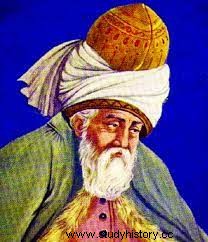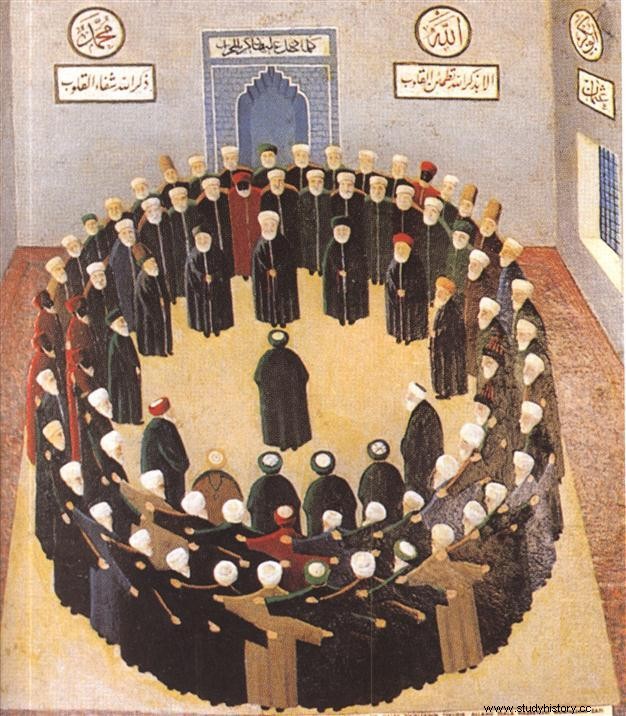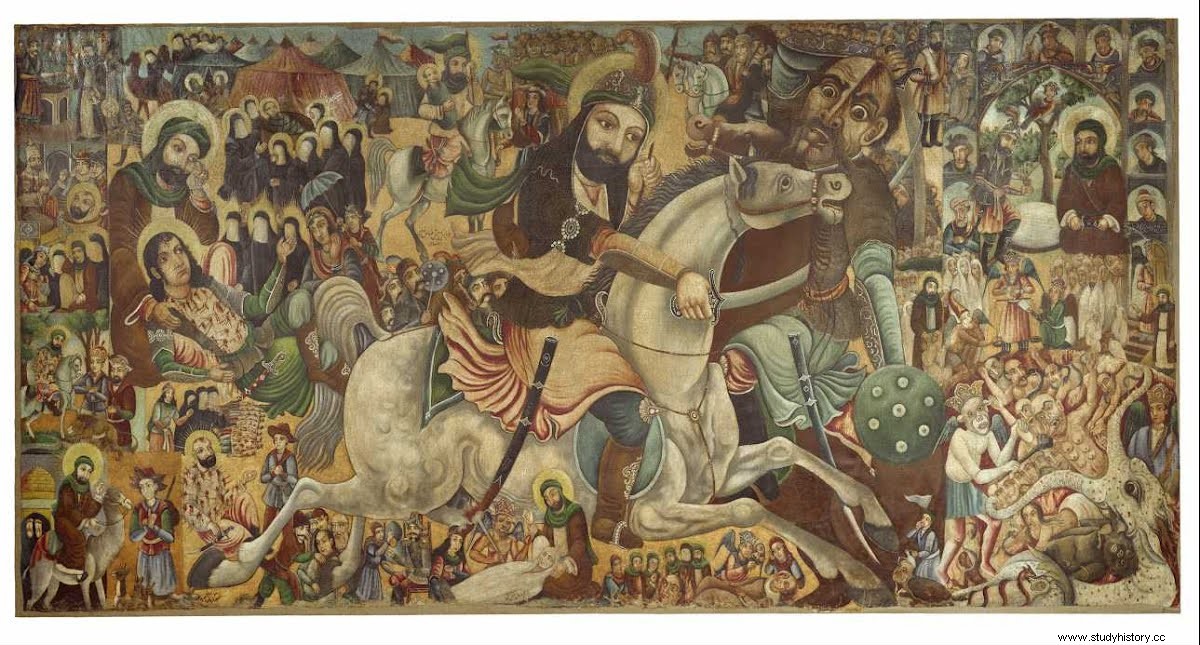" I'm not this hair, I'm not this skin, I'm the soul that lives inside. ”
Jalal Al-Din Muhammad Rumi
Jalal Al-Din Muhammad Rumi is one of the most enduring poets and thinkers in Islamic history. His deep, beautiful prose - which discusses the nature of love, life and soul - has made him a lasting figure in both Eastern and Western history.
It is probably because of this that Rumi has emerged as the figurehead of Sufism, especially in the West. Sufism - a branch of Islam known for its mysticism - has long been seen as the religion's most peaceful, apolitical form. With Rumi, the peaceful poet, at the helm, it is no wonder that this stereotype has taken hold.
However, there is only as much of Sufism as Rumi's poetry can cover. This article will explore the nature and history of Sufism and Islamic mysticism, as well as its practitioners and their fascinating rituals.
What is Sufism?

Although people often relate Sufism to mysticism, it can be defined more precisely as a way of thinking within Islam. It deals with worship in a unique form, usually through music, decorative art and unorthodox ways of living.
The term Sufism probably originates from the use of wool (suf in Arabic), an act associated with mystics. It can also come from the Arabic word for purity (safa). Others have argued that the word comes from the term "ahl as-suffah" (which means "the people in the sofa (bench)"). This refers to a group of poor companions of the Prophet Muhammad (PBUH) who held regular gatherings of dhikr (the repetition of God's divine name, 99 of which are in Islam).
The most defining characteristics of Sufism include extreme self-punishment in the name of divine worship. Examples of this include excessive fasting or staying up all night as a form of prayer. The early Sufis would spend their days praying and rejecting the physical world in favor of the spiritual. Most of them had only their clothes, and nothing more.
These qualities were a consequence of the Sufi principle of "ma'arifa" (Arabic for "knowledge"), a way of knowing God that involves a series of internal transformations. These were aimed at transcending the physical world and the body.
What are some important religious practices?
Usually, Sufi practice would not be complete without including typical Islamic rituals (praying five times a day, fasting during Ramadan, etc.). These are often completed in addition to the "sunnah", a list of behaviors completed by the Prophet Muhammad (PBUH). This is done for the purpose of living a life as close to him as possible.
Of course, living such a life also requires turning away from the temptations of the physical world. This even includes the love of company and food - to encourage a life of loneliness, silence and even insomnia. Even more important is that purity is required from the inside out. Because of this, Sufi practice focuses heavily on overcoming pride, arrogance and envy.
An example of a Sufi practice is Muraqaba, which means "observance". This practice is very similar to ordinary meditation, which is found across all faiths. Sufis turn their focus inward as they sing three times:"Ilahi anta maqsudi wa-ridaka matlubi" (my God, you are my goal and your joy is what I seek). Then they focus on the name of Allah and its spiritual meaning - "essence without equality". The Sufis remain present and awake for as long as they can, and finally complete the exercise.
Dhikr:One of the most central Sufi practices
In addition to this, Sufism involves several other specific practices, such as dhikr. This means "memory", this means remembering the name of Allah (God) 99. It can also refer to the practice of maintaining awareness of God's eternal presence. Most Sufi practices require Sufi initiation or guidance by a Sufi master. However, this practice, which is necessary for all Muslims, does not.
Different Sufi orders practice dhikr in different ways. For some, it is a ceremony known as sema. This involves various forms of worship, such as recitation, singing, meditation, and trance. It is this method that has given rise to the popular Sufi swirling (derived from the Mevlevi order), for which Sufis are perhaps best known. However, the traditional view of the Sunni Muslim Sufi orders (such as Chisti and Qadiriyya) forbids swirling under dhikr, viewing it as disrespectful to God.
Sufi vortex is a form of active meditation. It encourages one to leave his nafs (ego or self) by listening to music, focusing on the essence of God and spinning repeatedly in circles. The ultimate goal is to realize the source of all perfection - or perfection (whole). The rotating motion is meant to recreate the motion of the planets orbiting the sun.
Philosophies and Beliefs

Sufi's primary desire is a personal connection with God while they are still alive. This contradicts traditional Muslim beliefs, which claim that this connection will arise after their resurrection. This experience is supposedly so wonderful that it can only be expressed through metaphors. This fact explains the prevalence of images of alcohol and love in Sufi literature.
In Sufi literature, the joy of divine union often accompanies the misery of being separated from God. This gives rise to one of the main problems in the Sufi philosophy - the question of how a mortal being can come into contact with the infinite God. This connection, called "fana" ("destruction"), occurs in the last stages of spiritual development. One loses one's individual identity and only becomes aware of God's presence in them.
A story of Sufism:From the Prophet to the present

The origins of Sufism lie in the life of the Prophet Muhammad (PBUH). Early accounts report that he had a habit of meditating in a cave and living simply and modestly. This behavior formed the basis of Sufi practice. Besides the Prophet himself, his cousin and son-in-law, Ali, is also one of the first Sufis. In addition to being the man closest to the Prophet, open to receiving his mysterious knowledge, Ali was also the first male Islamic convert. As an official movement, however, Sufism began around 100 years after Ali's death.
In the late 8th century, a school for the famous mystic known as Hasan al-Basri established a monastery in Abadan. Meanwhile, others began detailing Sufi practices in written documents. Some of the most famous early Sufis include the Bayazid Bistami. He was an Iranian Sufi who became known for his "shathiyat" - which were often dramatic statements about his connection to the divine unity (God). These, he claimed, were the result of lifelong self-cleansing. In his greatest devotion to the sunnah (living life as close to the Prophet as possible), he even refused to eat a watermelon, because he found no evidence that the Prophet ever ate one.
The 10th Century:An Early Transition Period
At the end of the 10s and the beginning of the 11s, a transition phase began. Before the 10s, Sufism was defined by its temperament and the individuality of its followers. During this period, however, it shifted to a more common practice. This, of course, required greater organization and involved a greater number of followers. There was also a greater focus on formalizing the Sufi doctrine. Sufi leaders from the 10th century canonized previous figures and tried to demonstrate the connection between their practice and Orthodox Islam.
During this period, one of the most widespread contemporary Sufi books appeared: Kitab alta-arruf li-madhab ahl al-tasawwuf . This book was written by Abu Bakr Kalabadhi and explained Sufi terminology, beliefs and essential practices for students. Other well-known manuals summarizing Sufi philosophies began to appear, including Kashf al-Mahjub by Ali Hujwiri and Risala by Al-Qushayri. Another famous figure, Abu Abd al-Rahman Sulami, wrote many works on Sufism and ethics, most notably the concept of Sufi chivalry ("futuwwa").
Other well-known figures include Khwaja Abd Allah Ansari and Abu Said ibn Aby al-Khayr, both of whom contributed to the development of Sufism as a movement. The latter, an Iranian Sufi, lived a reflective life under the leadership of a Sufi master for fifteen years. After that, he organized two Sufi centers, one in Mehana and the other in Nishapur - an Iranian hub at the time.
13s:Development and Reform
During the 12th and 13th centuries, Sufi orders began to form. They were also called "turuq" (paths) collectively, and "tariqa" in the singular. Examples include Qadiriyya, Shadhiliyya, Rifa'iyya and Chistiyya. Each tariqa, based on the teachings of a holy founder (usually an Islamic scholar), had its own practices, beliefs, and literature. This period also saw a shift in Sufi practice, to around the middle of the 18th century. At that time, the role of the Prophet Muhammad was seen as increasingly central to Sufi practice.
One of the most famous figures of the period is the Andalusian mystical philosopher, Muhyi al-din Ibn al-Arabi. His thoughts and works shaped many Sufi practices and beliefs. Central to his philosophy was the belief in "wahdat alwujud" (the being of unity). This suggested that the universe is the physical manifestation of God, and therefore forms part of him instead of being one of his separate creations.
This doctrine opposed the orthodox Islamic faith, which claimed that God is separate from his creations. This contradiction therefore made it one of the most controversial doctrines in Sufi philosophy. Consequently, the two centuries after his death saw a modified version of this doctrine. Known as "wahdat al shahada" (Unity of Witness), it was an attempt to compromise between al-Arabi's philosophy and common Muslim faith.
20s:Sufism in a Developmental Period
During the 14th to 18th centuries, Sufis began to solidify and spread their ideology across the continent. Although the mysterious nature of Sufi practices and orders appealed to many and contributed to widespread conversion to Islam, the ideology also suffered a major setback. In the eighteenth century, this resistance took a violent form with the appearance of the Wahhabi movement, a conservative movement within the Sunni Muslim branch of Islam.
In the early 1920s, reformists and socialists in the Muslim world began to criticize Sufi rituals and doctrines. Sufi orders were accused of maintaining superstition, being too outdated and holding back nations from progressive reforms. Westernizing national governments were often responsible for the political and educational reforms that perpetuated attacks on Sufism. This was done with the intention of weakening the economic basis of the Sufi orders. As a result, many Sufi orders in mostly Islamic countries began to decline.
Despite these developments, however, Sufism continues to play an important role - both in the Muslim world and, more recently, in the West.
Modern Sufism:Neosuphism
Coined by Fazlur Rahman (a Pakistani scholar and Islamic philosopher), the term neo-Sufism refers to the reformist currents among Sufi orders from the 18th century. These reformers sought to remove some of the more pantheistic elements of the Sufi tradition. Instead, they aimed to affirm conventional Islamic law, suggesting its role as the basis of inner spirituality and social activism.
More recently, however, the meaning of the term has evolved. It now refers to forms of Sufi-influenced spirituality in the West, especially those that emphasize the pantheistic elements of Sufism by taking it out of its Islamic context. Examples of this include Sufism Reoriented, a branch of traditional Sufism and The Golden Sufi Center. The latter, located in the United States, England and Switzerland, combines traditions with Hinduism and neo-Sufism. It is also the Sufi order in the West. Founded by Inayat Khan, it emphasizes the unity of all faiths and is open to members of all walks of life.
Currently, active Sufi academics, publishers and writers include Timothy Winter, Hamza Yusuf, Llewellyn Vaughan-Lee, Nuh Ha Mim Keller and Zaid Shakir.
The Impact of Sufism on Literature, Art, and Culture

Some of the most famous and talented figures in Islamic history have been Sufis. This includes Rumi, a 13 th- century Persian poet, often considered to be one of the greatest poets of all time. As proof of his lasting legacy, he has become one of the most widely read poets in the United States. His personal story with the Persian dervish Shams Tabrizi was even fictionalized and included in Elif Shafak's The Forty Rules of Love .
The visual arts have also explored the famous principles of Sufism, as illustrated in the image below. The battle of Karbala, the subject of the painting, was the result of a violent disagreement between the Sunni Muslims and the Shiites. During the battle, Husayn ibn Ali, a grandson of the Prophet Muhammad (PBUH), died and became an Islamic martyr. This is of course part of a larger story with beautiful Islamic visual art, calligraphy, and design.
The Importance of Sufism
Despite its conflicts with traditional Islam, Sufism is still an important part of Islamic and Eastern history. Although it is known as the mysterious brother of Islam, it is important to recognize it within the Islamic context and not distort the message, as some scholars have done, as a pantheistic or even anti-Islamic. Without Islam, Sufism might never have been born. And without Sufism, the beautiful works of art and traditions curated by practitioners through centuries of worship may never have existed.
References:
Islamic Mysticism in Asia . 08 08 2016. 03 08 2021..
Shihadeh, Ayman. "Introduction." Shihadeh, Ayman. Sufism and theology . Edinburgh:Edinburgh University Press, 2007. 1-12.
Sufism . and 03 08 2021..
